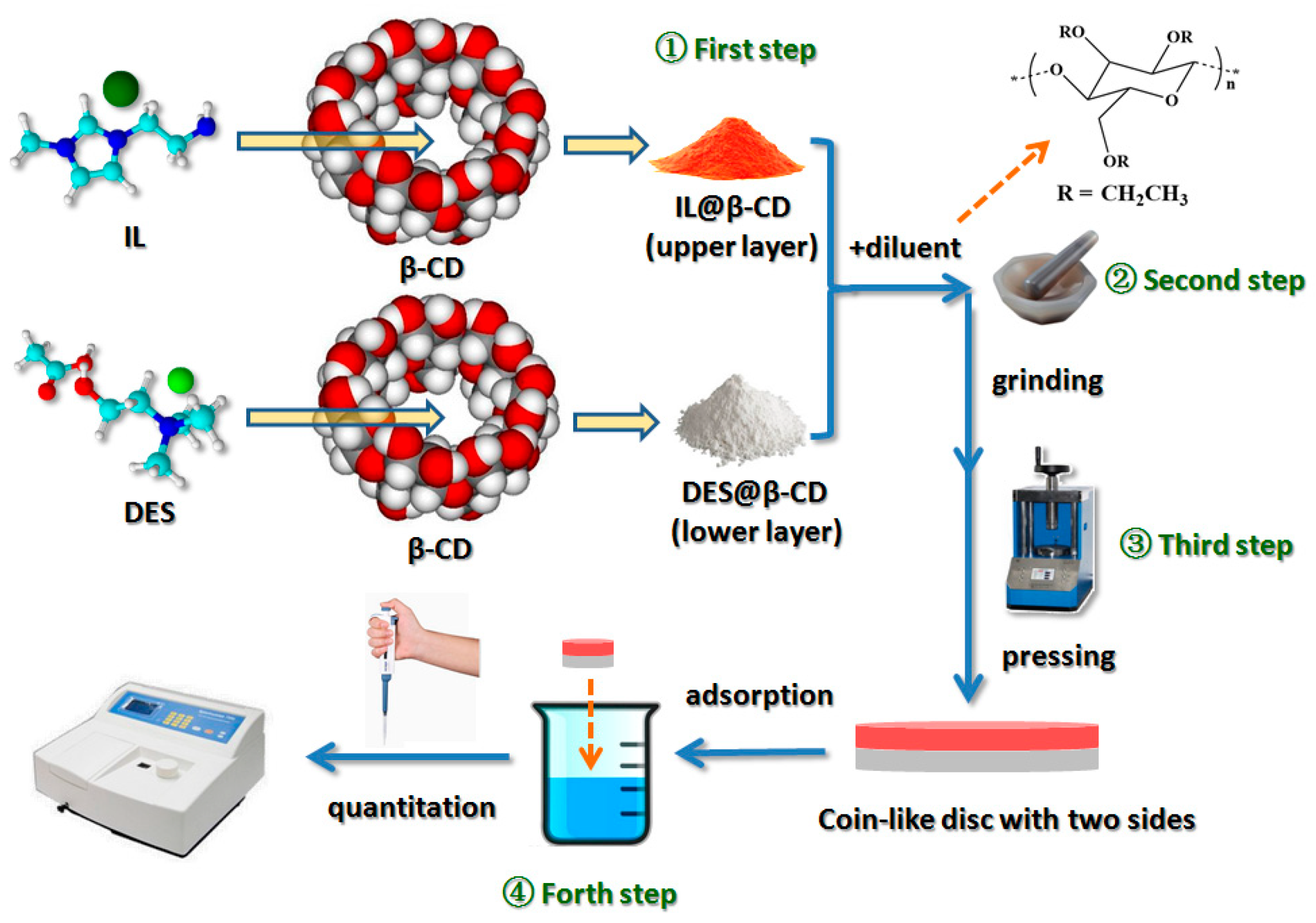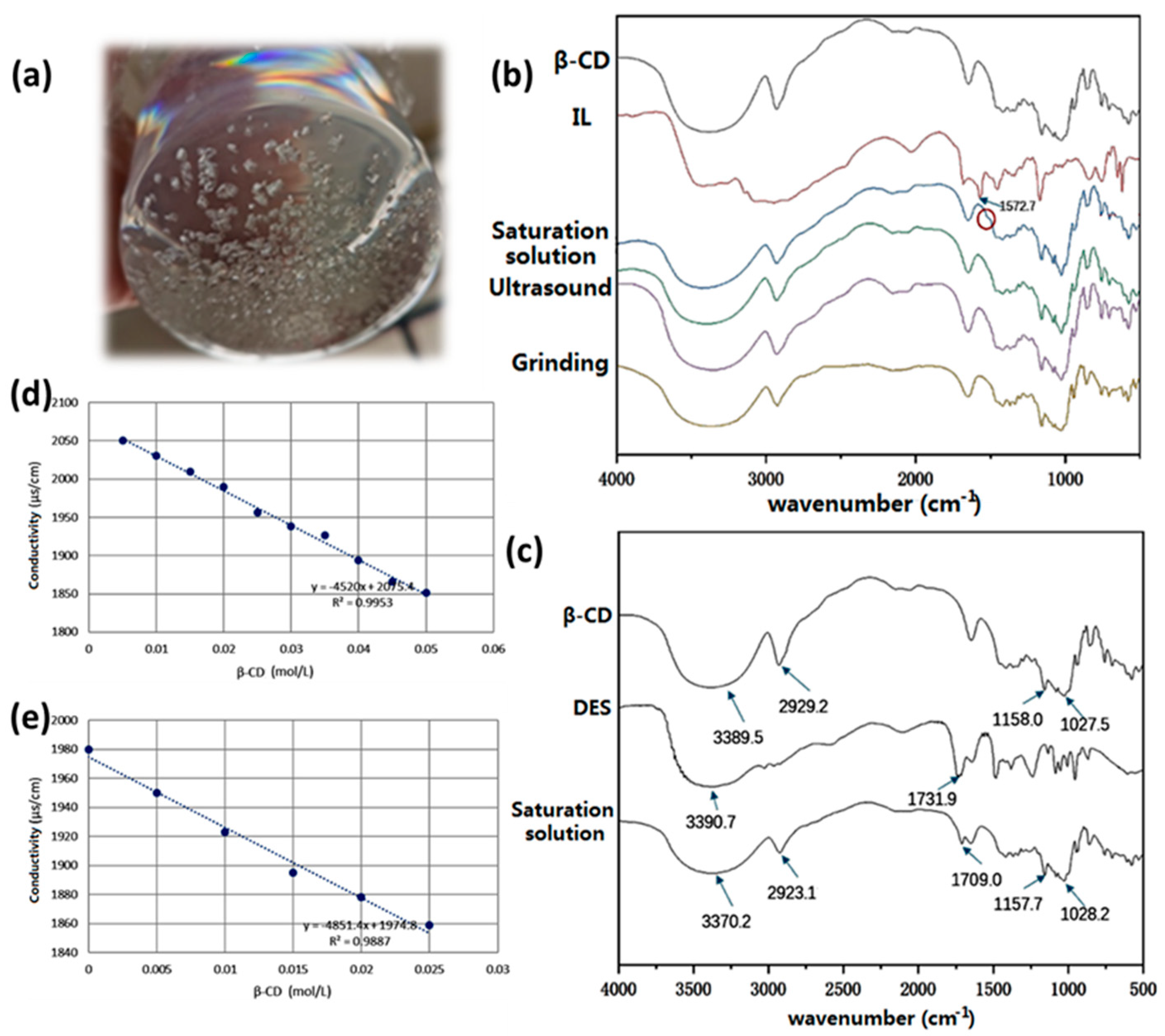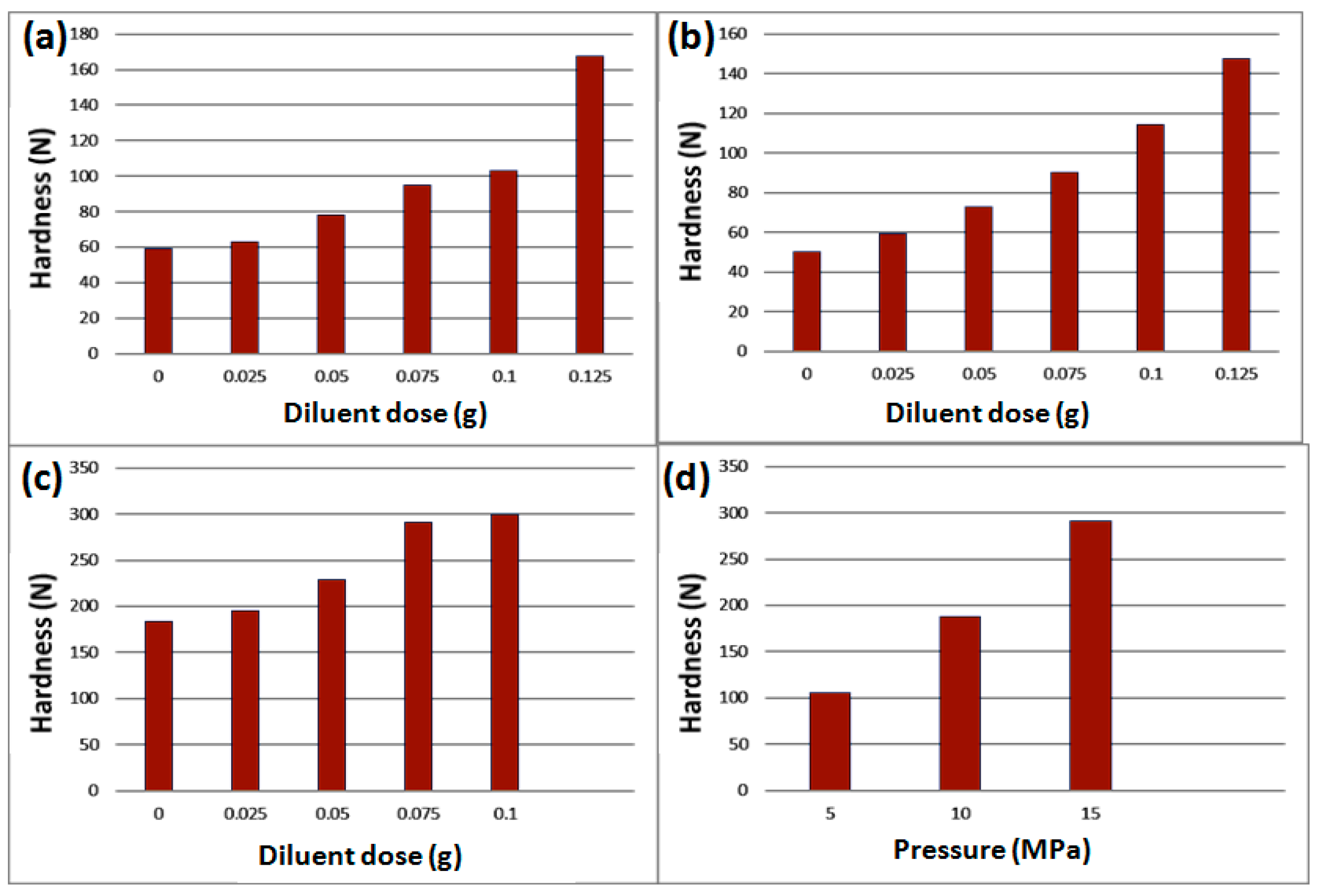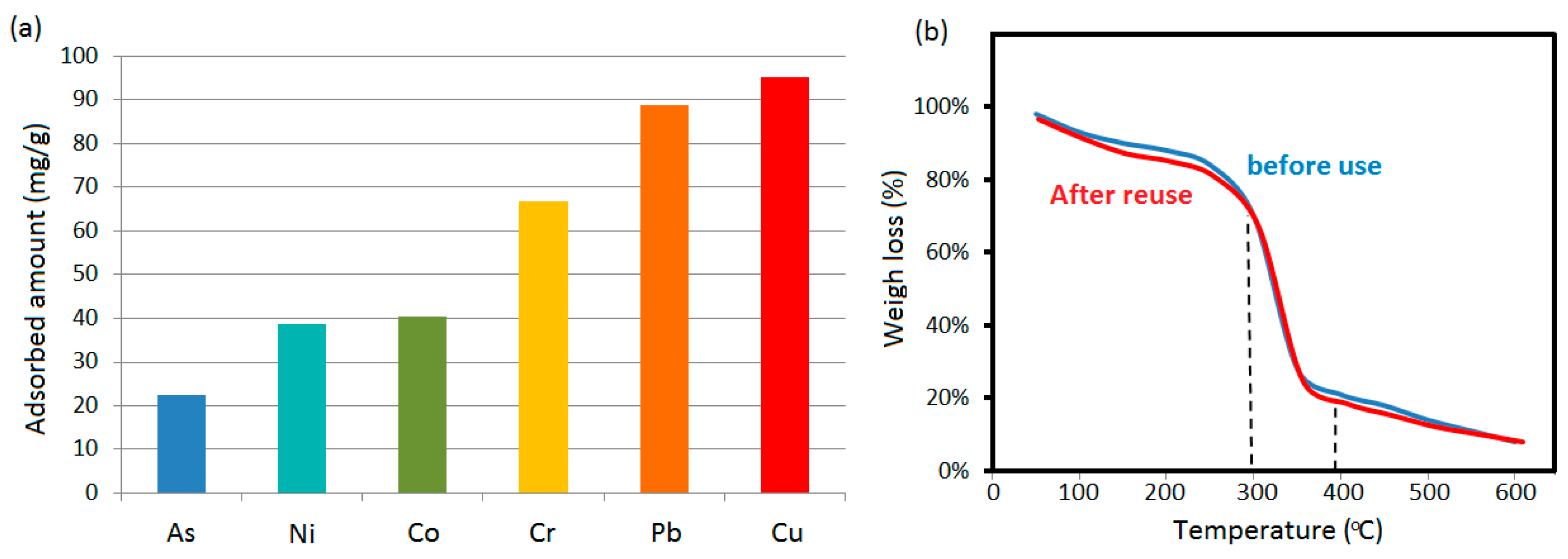Simple Preparation of a Unique Ionic Liquid/Deep Eutectic Solvent and β-Cyclodextrin Composite Discs and Its Use to Capture Hazardous Substances from Water
Abstract
1. Introduction
2. Materials and Methods
2.1. Reagents and Materials
2.2. Instruments
2.3. Preparation of IL and DES
2.4. Preparation of IL/DES@β-CD
2.5. Preparation of IL/DES@β-CD Discs
2.6. Removal of Hazardous Substances from Water
3. Results and Discussion
3.1. Structural Identification of the IL and DES
3.2. Loading of IL/DES on β-CD
3.3. Preparation of IL/DES@β-CD Sorbent Discs
3.4. Performance Validation of the Sorbent Discs to Capture Hazardous Substances
4. Conclusions
Author Contributions
Funding
Data Availability Statement
Acknowledgments
Conflicts of Interest
References
- Juni, F.; Bashir, M.J.K.; Haider Jaffari, Z.; Sethupathi, S.; Wong, J.W.C.; Zhao, J. Recent advancements in the treatment of emerging contaminants using activated persulfate oxidation process. Separations 2023, 10, 154. [Google Scholar] [CrossRef]
- Liu, X.; Lu, D.; Zhang, A.; Liu, Q.; Jiang, G. Data-driven machine learning in environmental pollution: Gains and problems. Environ. Sci. Technol. 2022, 56, 2124–2133. [Google Scholar] [CrossRef]
- Nitin, R.; Prabhat, K.S.; Nityanand, S.M. Pharmaceuticals in water as emerging pollutants for river health: A critical review under Indian conditions. Ecotoxicol. Environ. Saf. 2022, 247, 114220. [Google Scholar]
- Jaqueline, B.; João, H.Z.D.S. Chapter 3—Green Solvents for Remediation Technologies. In Green Sustainable Process for Chemical and Environmental Engineering and Science; Rajender, B.I., Abdullah, M.A., Eds.; Elsevier: Amsterdam, The Netherlands, 2021; pp. 23–30. [Google Scholar]
- Feng, X.; Song, H.; Zhang, T.; Yao, S.; Wang, Y. Magnetic Technologies and green solvents in extraction and separation of bioactive molecules together with biochemical objects: Current opportunities and challenges. Separations 2022, 9, 346. [Google Scholar] [CrossRef]
- Abu, H.N.; Abdul, S.N.; Siti, F.M.N.; Syafikah, H.P.; Muhammad, L.N.; Siti, M.N.H.; Rushdan, A.I.; Norzita, N.; Aznizam, A.B.; Zuliahani, A.; et al. Recent Advances in using adsorbent derived from agricultural waste for antibiotics and non-steroidal anti-inflammatory wastewater treatment: A review. Separations 2023, 10, 300. [Google Scholar]
- Kopac, T. Research progress on process-intensified water treatment applications. Separations 2022, 9, 353. [Google Scholar] [CrossRef]
- Wang, Y.; Li, W.; Luo, S.; Liu, S.; Li, J. Research advances on the applications of immobilized ionic liquids functional materials. Acta Chim. Sin. Chin. Ed. 2018, 76, 85–94. [Google Scholar] [CrossRef]
- Dowlatshah, S.; Saraji, M.; Pedersen-Bjergaard, S.; Ramos-Payán, M. Microfluidic liquid-phase microextraction based on natural deep eutectic solvents immobilized in agarose membranes. J. Chromatogr. A 2021, 1657, 462580. [Google Scholar] [CrossRef] [PubMed]
- Kakaei, S.; Khameneh, E.S.; Hosseini, M.H.; Moharreri, M.M. A modified ionic liquid clay to remove heavy metals from water: Investigating its catalytic activity. Int. J. Environ. Sci. Technol. 2019, 17, 2043–2058. [Google Scholar] [CrossRef]
- Yohannes, A.; Li, J.; Yao, S. Various metal organic frameworks combined with imidazolium, quinolinum and benzothiazolium ionic liquids for removal of three antibiotics from water. J. Mol. Liq. 2020, 318, 114304. [Google Scholar] [CrossRef]
- Fan, T.; Yan, Z.; Yang, C.; Qiu, S.; Peng, X.; Zhang, J.; Hu, L.; Chen, L. Preparation of menthol-based hydrophobic deep eutectic solvents for the extraction of triphenylmethane dyes: Quantitative properties and extraction mechanism. Analyst 2021, 146, 1996–2008. [Google Scholar] [CrossRef]
- Phosiri, P.; Burakham, R. Deep eutectic solvent-modified mixed iron hydroxide–silica: Application in magnetic solid-phase extraction for enrichment of organochlorine pesticides prior to GC-MS analysis. J. Sep. Sci. 2022, 44, 3636–3645. [Google Scholar] [CrossRef] [PubMed]
- Mao, X.; Liu, Y.; Chen, D.; Chen, Z.; Chunan, M.A. Electrochemical reduction of CO2 in [NH2-emim]Br/[Bmim]BF4 ionic liquid composite. CIESC J. 2017, 68, 2027–2034. [Google Scholar]
- Sethi, O.; Singh, M.; Kang, T.S.; Sood, A.K. Volumetric and compressibility studies on aqueous mixtures of deep eutectic solvents based on choline chloride and carboxylic acids at different temperatures: Experimental, theoretical and computational approach. J. Mol. Liq. 2021, 340, 117212. [Google Scholar] [CrossRef]
- Das, K.; Datta, B.; Rajbanshi, B.; Roy, M.N. Evidences for inclusion and encapsulation of an ionic liquid with β-CD and 18-C-6 in aqueous environments by physicochemical investigation. J. Phys. Chem. B 2018, 122, 1679. [Google Scholar] [CrossRef] [PubMed]
- Li, X.; Lee, Y.R.; Row, K.H. Synthesis of mesoporous siliceous materials in choline chloride deep eutectic solvents and the application of these materials to high-performance size exclusion chromatography. Chromatographia 2016, 79, 375–382. [Google Scholar] [CrossRef]
- Pedro, A.Q.; Coutinho, J.A.P.; Freire, M.G. Immobilization of Ionic Liquids, Types of Materials, and Applications. In Encyclopedia of Ionic Liquids; Zhang, S., Ed.; Springer: Singapore, 2022. [Google Scholar]
- Shah, R.V.; Pandey, A.K.; Kumar, S.J.; Paul, S.; Rao, R.M.; Jaison, P.G. One step sample treatment and loading using a deep eutectic solvent immobilized in a porous substrate for thermal ionization mass spectrometry of Pu(IV) ions. J. Anal. Atom. Spectrom. 2020, 35, 2315–2321. [Google Scholar] [CrossRef]
- Liu, B.; Zhou, Y.; Luo, X.; Qin, H.; Cao, S. FTIR spectral analysis of ionic liquids 1-buty 1-3-methylimidazolium bromine synthesis. Adv. Meas. Lab. Manag. 2007, 2, 13–14. [Google Scholar]
- Bratu, I.; Veiga, F.; Fernandes, C.; Hernanz, A.; Gavira, J.M. Infrared spectroscopic study of triacetyl β-cyclodextrin and its inclusion complex with nicardipine. Spectroscopy 2015, 18, 459–467. [Google Scholar] [CrossRef]
- Chen, C.; Feng, X.; Yao, S. Ionic liquid-multi walled carbon nanotubes composite tablet for continuous adsorption of tetracyclines and heavy metals. J. Clean. Prod. 2020, 286, 124937. [Google Scholar] [CrossRef]
- Marten, K.; Jian, X.W.; Jukka, R.; Jens, M.C.; Thomas, R.; Claudia, S.L. Multispectral UV imaging for fast and non-destructive quality control of chemical and physical tablet attributes. Eur. J. Pharm. Sci. 2016, 90, 85–95. [Google Scholar]
- Park, G.; Lee, J.H.; Kim, I.S.; Cho, J. Pharmaceutical rejection by membranes for wastewater reclamation and reuse. Water Sci. Technol. 2004, 502, 239–244. [Google Scholar] [CrossRef]
- Dietzel, B.M. Novel green technology for wastewater treatment: Geo-material/geopolymer applications for heavy metal removal from aquatic media. Int. J. Sediment Res. 2023, 38, 33–48. [Google Scholar]
- Zhang, T.; Jiang, W.; Cao, Y.; Zhu, C.; Toukouki, S.; Yao, S. A facile one-pot synthesis of ionic liquid@porous organic frameworks for rapid high-capacity removal of heavy metal ions, pesticides and aflatoxin from two non-food bioactive products. Ind. Crops Prod. 2022, 181, 114859. [Google Scholar] [CrossRef]
- Lee, S.P.; Ali, G.; Algarni, H.; Chong, K.F. Flake size-dependent adsorption of graphene oxide aerogel. J. Mol. Liq. 2019, 277, 175–180. [Google Scholar] [CrossRef]
- Wang, X.; Ying, C. UV-Vis detection-reversed- phase high performance liquid chromatography determination of basic red 1:1. Text. Aux. 1998, 5, 35–37. [Google Scholar]
- Kopsidas, O. Pigment adsorption optimization in various low cost adsorbents. J. Environ. Sci. Eng. A 2021, 10, 20. [Google Scholar] [CrossRef]
- Danner, M.C.; Robertson, A.; Behrends, V.; Reiss, J. Antibiotic pollution in surface fresh waters: Occurrence and effects. Sci. Total Environ. 2019, 664, 793–804. [Google Scholar] [CrossRef]
- Kozonoi, N.; Ikeda, Y. Extraction mechanism of metal ion from aqueous solution to the hydrophobic ionic liquid, 1-butyl-3-methylimidazolium nonafluorobutanesulfonate. Monatshefte Chemie-Chem. Mon. 2007, 138, 1145–1151. [Google Scholar] [CrossRef]
- Li, Z.; Tang, C.; Hu, S.; Wang, C. Preparation and dye-adsorption of ionic liquid loading molecular sieve. Chin. J. Environ. Eng. 2014, 8, 3848–3852. [Google Scholar]
- Lakshmi, D.S.; Santoro, S.; Avruscio, E.; Tagarelli, A.; Figoli, A. Preparation of polymer inclusion membranes (PIMs) with ionic liquid and its application in dye adsorption process supported by statistical analysis. Int. J. Membr. Sci. Technol. 2015, 2, 65–77. [Google Scholar] [CrossRef]
- Zhao, Y.; Zhang, L.; Zhai, X.; Liu, Q.; Sun, L.; Liu, M.; An, L.; Xian, L.; Zhang, P.; Chen, L. Study on adsorption performance of benzoic acid in cyclocarya paliurus extract by ethyl cellulose microspheres. Chemistry 2021, 3, 1113–1125. [Google Scholar] [CrossRef]
- Wang, T.; Li, B.; Feng, Y.; Guo, Q. Preparation, quantitive analysis and bacteriostasis of solid state iodine inclusion complex with β-cyclodextrin. J. Incl. Phenom. Macrocycl. Chem. 2011, 69, 255–262. [Google Scholar] [CrossRef]





Disclaimer/Publisher’s Note: The statements, opinions and data contained in all publications are solely those of the individual author(s) and contributor(s) and not of MDPI and/or the editor(s). MDPI and/or the editor(s) disclaim responsibility for any injury to people or property resulting from any ideas, methods, instructions or products referred to in the content. |
© 2023 by the authors. Licensee MDPI, Basel, Switzerland. This article is an open access article distributed under the terms and conditions of the Creative Commons Attribution (CC BY) license (https://creativecommons.org/licenses/by/4.0/).
Share and Cite
Guo, Y.; Liu, N.; Chen, H.; Ali, A.; Toufouki, S.; Yao, S. Simple Preparation of a Unique Ionic Liquid/Deep Eutectic Solvent and β-Cyclodextrin Composite Discs and Its Use to Capture Hazardous Substances from Water. Separations 2023, 10, 357. https://doi.org/10.3390/separations10060357
Guo Y, Liu N, Chen H, Ali A, Toufouki S, Yao S. Simple Preparation of a Unique Ionic Liquid/Deep Eutectic Solvent and β-Cyclodextrin Composite Discs and Its Use to Capture Hazardous Substances from Water. Separations. 2023; 10(6):357. https://doi.org/10.3390/separations10060357
Chicago/Turabian StyleGuo, Yingying, Na Liu, Hangping Chen, Ahmad Ali, Sara Toufouki, and Shun Yao. 2023. "Simple Preparation of a Unique Ionic Liquid/Deep Eutectic Solvent and β-Cyclodextrin Composite Discs and Its Use to Capture Hazardous Substances from Water" Separations 10, no. 6: 357. https://doi.org/10.3390/separations10060357
APA StyleGuo, Y., Liu, N., Chen, H., Ali, A., Toufouki, S., & Yao, S. (2023). Simple Preparation of a Unique Ionic Liquid/Deep Eutectic Solvent and β-Cyclodextrin Composite Discs and Its Use to Capture Hazardous Substances from Water. Separations, 10(6), 357. https://doi.org/10.3390/separations10060357







